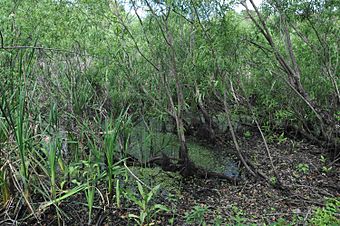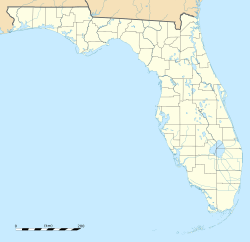Windover Archeological Site facts for kids
|
Windover Archeological Site
|
|
 |
|
| Location | Brevard County, Florida |
|---|---|
| Nearest city | Titusville |
| Area | 1.3 acres (0.53 ha) |
| NRHP reference No. | 87000810 |
Quick facts for kids Significant dates |
|
| Added to NRHP | April 20, 1987 |
| Designated NHL | May 28, 1987 |
The Windover Archeological Site is a very important place where scientists found ancient human remains. It's located in Brevard County, Florida, near Titusville. This site dates back to the Middle Archaic period, which was about 7,000 to 8,000 years ago.
Windover is a special kind of pond where the bones of 168 people were discovered buried deep in the muddy peat at the bottom. The peat helped keep the skeletons incredibly well-preserved. What's even more amazing is that brain tissue was found in many of the skulls! Scientists were even able to study the DNA from this ancient brain tissue. The human remains and tools found at Windover are some of the biggest discoveries from this time period, making it one of the most important archaeological sites ever found.
The Windover dig site is a small pond, about 1,000 square meters in size. It has had water in it continuously for a very long time, since around 9,000 to 8,000 BC. The pond is close to the Atlantic coast. Thousands of years ago, the sea level was much lower, so the pond was only filled by rain. Today, the pond also gets water from underground sources. In 1984, when it was excavated, the pond had a thick layer of peat, with the deepest part covered by about 1.8 meters of water.
Contents
How the Windover Site Was Found
An Accidental Discovery in 1982
The Windover site was found by accident in 1982. Workers were building a road for a new neighborhood called Windover Farms. A backhoe operator was digging in the pond when he noticed several skulls in his machine's bucket. The local police and medical examiner were called. They quickly realized these burials were very old, not recent.
Developers Help Fund Research
The people developing the land, Jack Eckerd and Jim Swann, immediately stopped construction at the pond. They called in archaeologists to investigate. The developers even paid for tests on two bones found by the backhoe. These tests, called Radiocarbon dating, showed the bones were about 7,210 and 7,320 years old! This proved how important the discovery was. Because of this, the developers changed their building plans to protect the pond. They also donated $60,000 worth of equipment to help drain the pond for the archaeologists.
Excavating the Ancient Pond
In 1984, the state of Florida approved money to dig up the pond. The work was led by Glen Doran and David Dickel from Florida State University. The buried bones were found about 1.8 meters or deeper beneath the peat, under 0.9 to 3 meters of water. To make digging possible, researchers used 160 wells around the pond to lower the water level. Workers used shovels and hand tools to carefully remove the peat. One archaeologist said digging the peat was like trying to dig chocolate mousse underwater! Only half of the pond was dug up, leaving the other half untouched for future studies.
Discoveries About Ancient People
Who Was Buried at Windover?
Scientists found the bones of 168 people at Windover. These included males and females of all ages, from babies to adults around 60 years old. About half of the remains were children. The average height for adult males was about 175 centimeters.
Health and Injuries of the People
The skeletons showed signs of diseases and healed injuries, which helped scientists learn about their lives. Many children's bones showed that their growth had stopped at times, possibly because of serious illness or not enough food. Older women often had Osteoporosis, a condition that makes bones weak. Many adults, both men and women, had osteoarthritis, a problem with joints. Some skeletons even showed injuries from fights, which might have caused their death. For example, one male's pelvis had a spear point stuck in it, and others had severe head injuries.
Special Burials and Grave Goods
Children and teenagers were buried with more special items, called grave goods, than adults. This suggests that children were highly valued in this ancient community. One skeleton belonged to a 15-year-old boy who had spina bifida, a condition that affects the spine. His bones were very fragile, and one of his feet was missing, but the stump of his leg had healed. Since his condition likely meant he couldn't move his legs, this discovery shows that his community cared for him for 15 years, even though they were hunter-gatherers.
How Bodies Were Buried
About 100 burials were found mostly undisturbed, with bones still in their correct body positions. Most bodies were buried in a bent position, lying on their left sides, with their heads facing west. Sharpened stakes were used to hold the bodies down in their graves. The bodies were buried in groups, in about five or six short periods over a thousand years. Thirty-seven graves contained woven fabrics, showing that these people had complex weaving skills and likely wrapped the bodies for burial.
Amazing Brain Preservation
In 1984, archaeologists made an incredible discovery: brain tissue had survived in many of the skulls! When skulls were opened, scientists found greasy, brownish material inside. They suspected it was brain tissue and sent the skulls for X-rays, CAT scans, and magnetic resonance imaging (MRI). These scans clearly showed recognizable brain structures. Under a microscope, even cell structures could be seen.
At least 90 of the recovered bodies had preserved brain tissue, thanks to the peat. This amazing preservation allowed scientists to figure out that the bodies were buried within 24 to 48 hours after death. Researchers were also able to study the DNA from these brains. The DNA showed that these people had an Asian origin, similar to other Native American groups. It also suggested that one family used this burial site for over a century.
What They Ate
Scientists also found contents from the stomachs of many buried individuals. These included seeds from wild grapes, elderberries, and prickly pear fruit, often in large amounts. The teeth of these people were worn down early in life, probably from sand in their food, but they had very few cavities.
Tools and Daily Life
Ancient Tools and Textiles
Many tools and items buried with the bodies were also preserved. Archaeologists found 86 pieces of fabric from 37 graves. These included seven different weaving styles, likely used for clothes, bags, mats, and possibly blankets or ponchos. Other tools, like atlatls (spear throwers) and projectile points (like arrowheads), were also found.
Hunting, Fishing, and Gathering
The people of Windover hunted animals, fished, and gathered plants. They used bottle gourds for storage, which is the earliest evidence of plant containers found in North America. Animal bones and shells in the graves showed that they ate white-tailed deer, raccoon, opossum, birds, fish, and shellfish.
Other Underwater Burials
Windover is one of several ancient sites in Florida where people were buried underwater in peat. Similar burials were found at Little Salt Spring, Bay West, and Republic Grove. Another site, Manasota Key Offshore, was found underwater in the Gulf of Mexico in 2016. It was a freshwater pond when burials happened there 7,200 years ago.
At Windover, stakes were driven through fabrics wrapped around the bodies into the peat. Similar stakes were found at Bay West, Republic Grove, and Manasota Key Offshore. These stakes might have been used to hold the bodies underwater. Some Native American groups have traditions that water blocks the spirits of the dead. This might explain why these ancient people chose to bury their dead in ponds.
Why Windover Is Important
The Windover Pond site is one of several discoveries in Florida since 1970 that have greatly changed what we know about the Archaic period. Jerald T. Milanich, a famous archaeologist, said that Windover has given us "unprecedented and dramatic" information about early people in Florida. He believes the Windover site might be "one of the most significant archaeological sites ever excavated." Because of its great importance, the site was named a National Historic Landmark in 1987.
Images for kids




